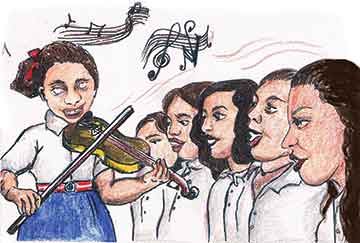Beula Christy
Equal access to education is a matter of right and not a privilege. Inclusive education is about all children learning together even if they differ from each other in styles and pace of learning. In India, the right to education and to equal educational opportunities has been guaranteed by the Constitution right from its independence. Article 45 of the Indian Constitutional law promises ‘free and compulsory education for all children until the age of 14 years’. The National Education Policy (NPE 1968) suggests an ‘integrated programme’ enabling handicapped children to study in regular schools. The government ‘Project for Integrated Education Development (PIED 1987) insisted on inclusive education wherever feasible with that of others’. The demand for inclusive education has re-emerged in India following the enforcement of three major initiatives: firstly, The Persons with Disabilities Act – 1995 that enforces equal opportunities, protection of rights and full participation; secondly, the flagship program ‘Sarva Shiksha Abhiyan’ for achievement of Universalization of Elementary Education (UEE) through the concept of ‘Zero rejection Policy’; and thirdly, the ‘ Right to Education’ Act that insists on free and compulsory education and admission of children in nearby schools to the extent possible.
 Despite all these efforts, it is disturbing to find that more than half of the population of children and youth with disability are denied these rights and do not receive adequate schooling in an appropriate environment. Cultural beliefs, prejudice, indifference, apathy from the community and inaccessible schools due to lack of management support, inadequate resources in terms of finance, manpower, lack of teacher awareness on how to handle these children in regular schools, all have a part to play in the exclusion of children with disabilities.
Despite all these efforts, it is disturbing to find that more than half of the population of children and youth with disability are denied these rights and do not receive adequate schooling in an appropriate environment. Cultural beliefs, prejudice, indifference, apathy from the community and inaccessible schools due to lack of management support, inadequate resources in terms of finance, manpower, lack of teacher awareness on how to handle these children in regular schools, all have a part to play in the exclusion of children with disabilities.
Every child is unique and capable of learning and developing in diverse ways and at different rates. In order to respond to the needs of each learner including those with disability, we need to create a regular class environment that nurtures the acceptance of diversity and promotes friendships based on reciprocity and mutual respect.
Key factors contributing to successful inclusion
a) Government as the primary stakeholder: In order to make the inclusive program successful it is important to identify and fill the gaps between the policies and its implementation procedures. The views of educationalists need to be understood and addressed clearly as they are key contributors towards inclusive education. Inclusion without adequate preparation of general schools will not yield satisfactory results. It is essential that issues related to infrastructural facilities, curriculum modification, and educational materials be addressed by the government.
b) Teacher education in handling disabled children in a regular classroom: The teachers’ lack of knowledge on disability issues, little or no experience in handling children with disability, uncertainty about their roles in handling disabled vs. non-disabled children in the same environment, inadequate training in teaching the disabled children result in a high percentage of educators holding negative attitudes towards inclusion. Similarly, large class sizes, poorly equipped classrooms and inadequate buildings can also conspire to sap a teacher’s morale and make their best efforts largely ineffective. Class teachers need support. A key influence is the leadership provided by the head teacher but tangible support provided by the management and the wider community is also vital as is the backing of colleagues through staff meetings and informal advice. In order to promote positive thought on inclusion, teachers should be trained in handling students with disabilities in the regular classroom. The training should cover areas such as identification of children with disabilities, understanding the strengths and needs of individual children, various special skills/techniques to be adopted in teaching these children in the classroom, development of appropriate teaching-learning material, and innovative ways of promoting inclusion in their classroom.
c) Sensitize non-disabled children on disability issues: Carefully planned learning activities through peer-group interaction are likely to enhance the learning experiences of disabled and non-disabled students. Teachers should think of innovative ways to sensitize the needs of disabled children among the non-disabled children in the classroom. Young children may be curious to know about disability conditions but generally they do not have the tendency to discriminate and isolate children on the basis of caste, religion, disability, etc. As the child grows, prejudices also grow and as a result, discrimination takes place. In order to reduce the discriminatory approaches, positive orientation can be given to non-disabled children. To create awareness on disability conditions the teacher could plan simulation exercises in the classroom. In order to simulate disability conditions, non-disabled children could be blindfolded for some time, their ears could be plugged for some time, and they could also be asked to walk using one leg, write without the help of the thumb, etc., to experience disability conditions of different natures. Often, non-disabled children find simulating exercises fun, at the same time, they also understand how children with disabilities live and learn. These type of simulating exercises will improve the concern of non-disabled children towards their disabled classmates.
 Similarly, the class teacher can orient the non-disabled children on the basics of ‘Plus curricular activities’, which are mandatory for children with disability for learning (Eg. The basics of braille, sign language, etc.). When children without disabilities are introduced to such basics, it helps facilitate inclusion for children with disabilities. Disabled children appreciate non-disabled children studying these skills as they bring them closer to the mainstream.
Similarly, the class teacher can orient the non-disabled children on the basics of ‘Plus curricular activities’, which are mandatory for children with disability for learning (Eg. The basics of braille, sign language, etc.). When children without disabilities are introduced to such basics, it helps facilitate inclusion for children with disabilities. Disabled children appreciate non-disabled children studying these skills as they bring them closer to the mainstream.
Other activities such as drama, skit, role play, etc., involving disabled and non-disabled children can also provide opportunities for effective inclusion of disabled children in the mainstream society.
d) Effective parental involvement: Parental involvement is an important part of making inclusive education work. First of all parents should understand that their child has a right to be in a neighbourhood school and in a regular classroom and that they don’t have to depend on the whims and fancies of the authorities concerned.
Parents should play a vital role in the education of their children with special needs by working in partnership with educators and other service personnel. They should work closely with the class teacher in rendering necessary help to make the learning process easier for the disabled child. They should actively be involved in the planning, development, and implementation of their children’s education program.
Inclusive education will not come quickly as it requires changes to a national system that has been long established; that has always been slow to alter, and which challenges the vested interests of powerful groups in society. But more than that inclusive education requires changes in the attitudes and practices of families and communities and of other systems such as health services and community work. Against all these forces, it is perhaps remarkable that the concept of inclusive education has advanced as much as it has.
The author is Consultant and Head – Vision Rehabilitation, L V Prasad Eye Institute, Hyderabad. She can be reached at beula@lvpei.org.
Related articles
Inclusive education
Confronting my sense of inclusion
Inclusion in practice
Building an ‘able’ society
Falling through the cracks
Everyone’s in!
